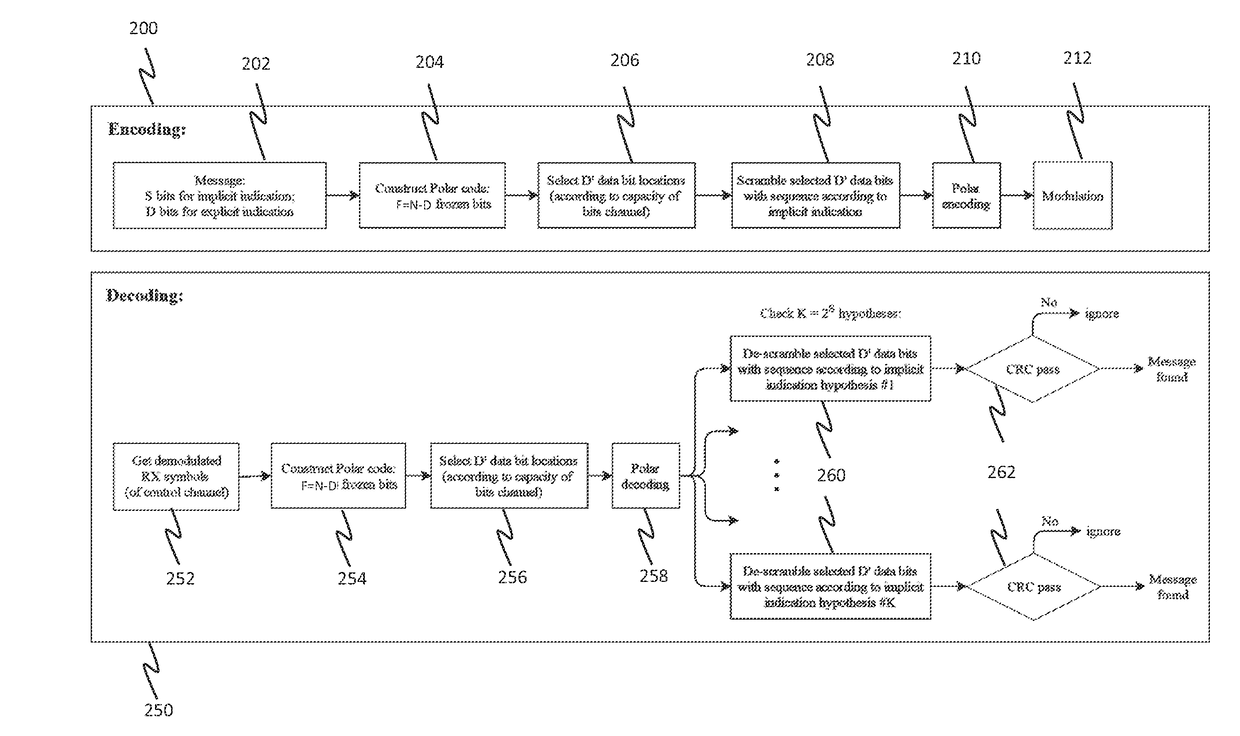Transmitting and receiving data using polar codes
a technology of polar codes and data, applied in the direction of digital transmission, code conversion, code conversion, etc., can solve the problems of polar codes not parallelizable, large block length latency requirements, and increase the complexity of list decoder implementation, so as to achieve greater hamming distance, maximum hamming distance, and reliability of virtual channels
- Summary
- Abstract
- Description
- Claims
- Application Information
AI Technical Summary
Benefits of technology
Problems solved by technology
Method used
Image
Examples
first embodiment
[0125]the present invention will now be described with reference to FIG. 2 which schematically illustrates a method 200 for encoding data and a method 250 for decoding data according to an embodiment of the present invention.
[0126]At a step 202, the method 200 for encoding data receives a block of data or message to be transmitted. The message includes D bits which are to be explicitly indicated. In other words, these D bits of the message or data block map onto the virtual channels provided by the Polar code. The message also includes S bits which are to be implicitly indicated. That is to say, these S bits of the message or data block form additional data which will be transmitted by the method 200.
[0127]At a step 204, the method 200 constructs the polar code such that it has D data bits to accommodate the D bits of the message which are to be transmitted. The polar code therefore also has a number F of frozen bits given by F=N-D where N is the code block length. It will be apprec...
second embodiment
[0138]the invention will now be described with reference to FIG. 3 which schematically illustrates a method 300 for DCI decoding in a specific cell ID.
[0139]In LTE, the attached CRC of DCI payload is masked with the RNTI to indicate the UE that the DCI is addressed to it, and the whole signal is scrambled with cell-ID based pseudo random sequence to reduce the inter cell interference (DCI transmitted from one eNB detected as from another eNB for same RNTI, and possibly different UEs).
[0140]In this second embodiment, rather than using a number of distinct different scrambling codes which are each associated with a different value of additional data, the additional data itself is used to form the scrambling code which is applied to the data bits on the D′ virtual channels. The first four steps 252, 254, 256 and 258 of the method 300 are the same as for the method of receiving data according to the previous embodiment. However, in steps 302 and 304, only a single hypothesis is formed a...
fifth embodiment
[0145]In the invention, puncturing information for URLLC / eMBB multiplexing is implicitly signalled in PDCCH together with the agreed explicit puncturing indication for URLLC / eMBB multiplexing. Repeat puncturing signalling can improve knowledge of punctured data at eMBB UE and / or provide finer info on the punctured resource. This can provide or more of: a reduced need for ReTx; reduced explicit signalling; and improved eMBB throughput. Optionally, an explicit signal in the DCI at the end of slot where puncturing happens can be used to inform the receiver that information about puncturing will be resent implicitly. Then, at the next slot, on another DCI, the puncturing information is implicitly resent.
PUM
 Login to View More
Login to View More Abstract
Description
Claims
Application Information
 Login to View More
Login to View More - R&D
- Intellectual Property
- Life Sciences
- Materials
- Tech Scout
- Unparalleled Data Quality
- Higher Quality Content
- 60% Fewer Hallucinations
Browse by: Latest US Patents, China's latest patents, Technical Efficacy Thesaurus, Application Domain, Technology Topic, Popular Technical Reports.
© 2025 PatSnap. All rights reserved.Legal|Privacy policy|Modern Slavery Act Transparency Statement|Sitemap|About US| Contact US: help@patsnap.com



